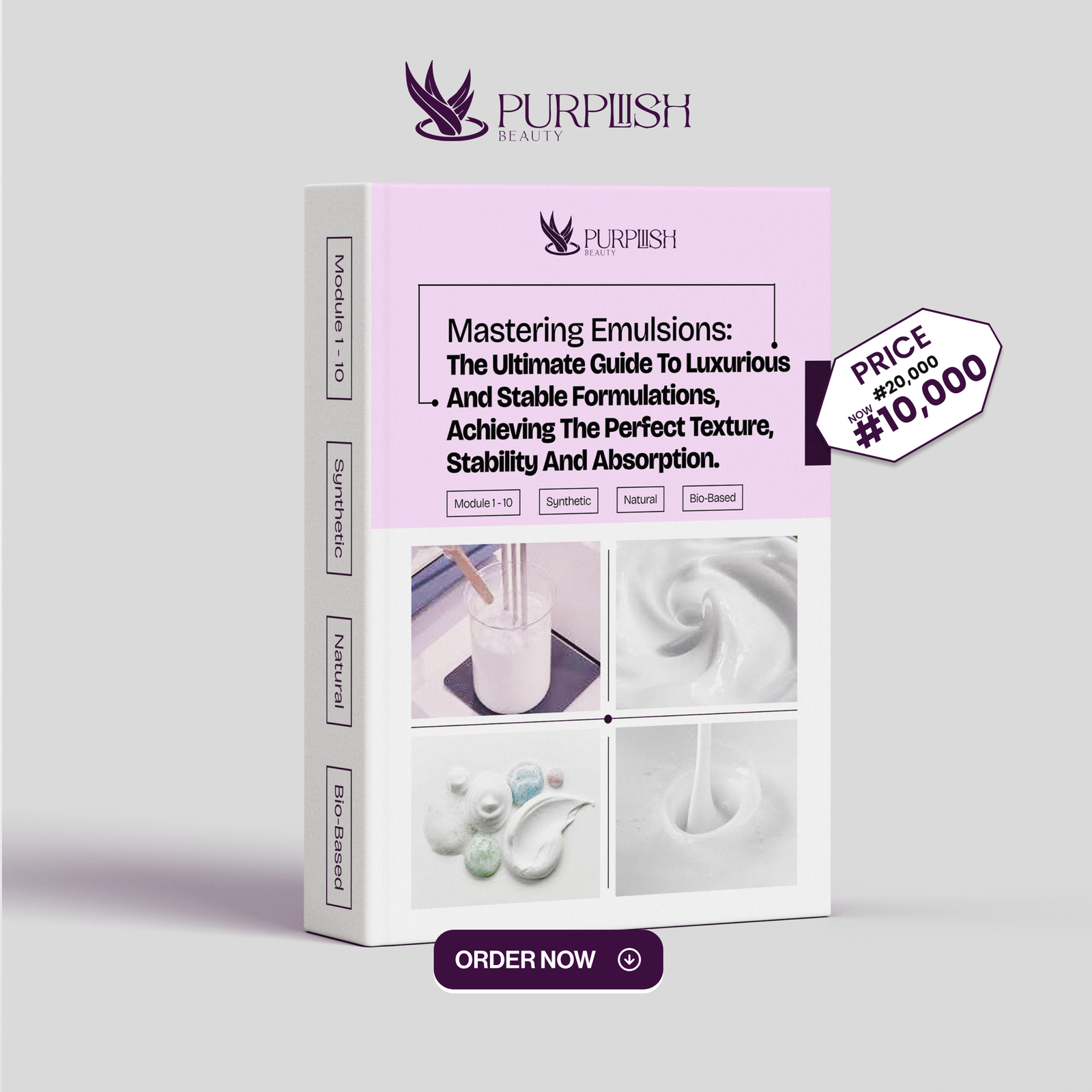Description
Mastering Emulsions
Introduction to Emulsions: The Art and Science of Formulating Stable Skincare Products
Module 1 – Module 10
Emulsions are the foundation of many skincare and cosmetic products, from luxurious face creams and lightweight lotions to rich body butters and silky serums. Understanding how emulsions work is essential for any formulator, skincare entrepreneur, or cosmetic chemist looking to create high-performance products that are both effective and stable. This course is designed to take you step by step through the science, techniques, and formulation principles behind emulsions. Whether you are new to formulation or looking to refine your skills, this ebook will provide you with a deep understanding of emulsification, from selecting the right ingredients to troubleshooting stability issues.
What You Will Learn in This Course
- The Science Behind Emulsions – What emulsions are, how they form, and why they are essential in skincare formulations.
- Types of Emulsions – Oil-in-water (O/W) vs. water-in-oil (W/O) emulsions, their characteristics, and when to use each type.
- Choosing the Right Emulsifiers and Co-Emulsifiers – How emulsifiers work, HLB values, and selecting the best emulsifier pair for different products
textures. - Hot Process vs. Cold Process Emulsions – When to use each method, the required emulsifiers, and step-by-step formulation guides.
- Texture and Consistency Control – How to create everything from lightweight lotions to rich creams using thickeners, stabilizers, and co-emulsifiers.
- Stability and pH Considerations – Understanding surface tension, interfacial energy, and how to prevent separation over time.
- Luxury and High-Performance Emulsions – How to formulate high-end emulsions with premium textures and advanced active ingredients.
By the end of this course, you will be equipped with practical formulation knowledge and the confidence to create stable, high-quality emulsions tailored to different skin needs.
COURSE OUTLINE
MODULE 1:Understanding Emulsions
- What are emulsions?
- Role of emulsions in skincare and cosmetics
- Difference between oil-in-water (O/W) and water-in-oil (W/O) emulsions
- How to achieve oil-in-water emulsions and water-in-oil emulsions
- Choosing the right type for your formulation
- Percentage of Water-to-Oil Ratio for Different Emulsion Types
MODULE 2:The Science Behind Emulsions
- How emulsions are formed
- Role of temperature in Emulsion formation
- Emulsifiers and Co-Emulsifiers with Their HLB Value
- How to Combine Emulsifiers for Stability
- Role of surface tension and interfacial energy
- How emulsifiers work to stabilize emulsions
- pH and its effect on emulsions
- Different Emulsifiers and Co-Emulsifiers with Their pH Range
MODULE 3:Emulsifiers and Co-Emulsifiers
- Categories of emulsifiers: synthetic, natural, and bio-based
- Understanding HLB (Hydrophilic-Lipophilic Balance) and how it affects emulsification
- How co-emulsifiers enhance stability and texture
3MODULE 4: Texture and Consistency in Emulsions
- Choosing the right emulsifier-co-emulsifier pair for the desired texture
- How to create thick, rich creams vs. light, fluid lotions
- Adjusting viscosity with stabilizers and thickeners
MODULE 5: Hot vs. Cold Process Emulsions
- When to use the hot process and why
- Cold process emulsifiers and their benefits
- Step-by-step formulation for each method
MODULE 6:Luxury Emulsions
- Elevating Your Formulations
- Ingredients that enhance sensory feel and performance
- High-end actives for premium skincare
- Techniques for achieving silky, fast-absorbing textures
MODULE 7:Fast-Absorbing Emulsions
- Key ingredients that improve absorption
- Emulsifiers that create non-greasy, lightweight formulas
- Adjusting the oil-to-water ratio for better penetration
MODULE 8:Formulation Techniques, Balancing Oils and Water
- Understanding oil phase vs. water phase
- 4How to determine the correct ratio for stability and performance
- Common formulation mistakes and how to fix them
MODULE 9:Practical Sessions and Formulation Exercises
- Hands-on formulation of different emulsions
- Troubleshooting common emulsion failures
- Customizing emulsions based on skin type and product function
MODULE 10: Full formulation workbook for all emulsion types
- Lightweight face lotion
- Nourishing body cream
- Barrier repair cream
- Cold-processed gel cream
- Brightening face lotion
- Emulsified body butter
- Hydrating milk lotion
- Non greasy hand and foot cream
- Soothing facial moisturizer
- Barrier repair cream for dry , compromised skin


Reviews
There are no reviews yet.